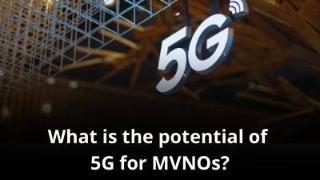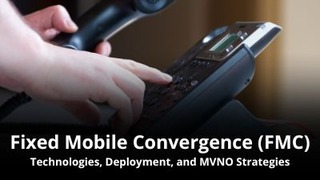Introduction about Fixed Mobile Convergence (FMC)
Fixed Mobile Convergence (FMC) is a telecommunications strategy representing the technological and strategic fusion of fixed-line (wireline) and mobile (wireless/cellular) networks and services. The fundamental purpose of FMC is to establish a single, monetizable, and unified communication service environment for the end user. This applies irrespective of their location, access technology, or device.
Lets look at the details of FMC. We cover historical evolution, core technologies, network integration principles, deployment models, business strategies, and relevance for operators, enterprises, and MVNOs in the modern telecommunications landscape.
What do you need to know about Fixed Mobile Convergence (FMC)
- Defining Convergence and Its Evolution
- Core Technologies and Network Integration
- Strategic Drivers and Business Value
- Commercial Deployment Models
- Advantages and Disadvantages of FMC
- Operator Strategy and Organizational Challenges
- Strategic Advantages of FMC for MVNOs
- Frequently Asked Questions (FAQs)
- Summary
Defining Fixed Mobile Convergence and Its Evolution
The history of Fixed Mobile Convergence
Historically, fixed and mobile networks operated as entirely separate infrastructures. They often functioned as mutually exclusive systems. This separation included network architecture, service provisioning, billing platforms, and operational divisions within telecommunications companies.
FMC’s central objective is to dismantle these operational and technical silos. The goal is to enable unified service delivery and maximize commercial potential.
Early Fixed Mobile Convergence (FMC) Initiatives
The earliest FMC initiatives, dating to the early 2000s, primarily addressed the technical limitations of 2G and 3G cellular technology. These limitations included poor indoor coverage and high per-minute costs. These efforts introduced the concept of seamless handover or call continuity. The aim was to retain revenue and ensure uninterrupted service by transferring an ongoing call between a cellular network and a fixed-access network (like Wi-Fi) on a dual-mode handset. However, the disparity between circuit-switched voice on 2G/3G and packet-switched voice over Wi-Fi existed. Coupled with immature technology, this often led to unreliable performance. As a result, consumer adoption was limited.
Enterprise-Led FMC Adoption
The most successful early application of FMC emerged in the enterprise sector. Solutions included Extension to Cellular (X-to-C). These systems integrated mobile devices as virtual extensions of corporate PBXs. They achieved true service convergence. This established the critical “One Number, One Voicemail” paradigm. Businesses could centralize telephony features and optimize operational efficiency for mobile workforces.
The Modern Era of FMC
Today, FMC has matured through the widespread deployment of IP Multimedia Subsystem (IMS) architectures and 4G/5G all-IP networks. These technologies form a unified backbone. They treat all communications — fixed or mobile — as standardized IP data packets. This makes full technical and service convergence reliable and commercially viable.
Core Technologies and Network Integration of FMC
Access Layer Technologies
The goal of the access layer is to standardize the communication path. This is done regardless of connection type.
- Voice over LTE (VoLTE) and Voice over 5G (VoNR): Digitize voice communications and transmit them as IP data packets. This ensures voice is treated equivalently to other data services and monetized consistently.
- Wi-Fi Calling (VoWiFi): Enables mobile devices to connect to the cellular core via any Wi-Fi access point. It effectively uses Wi-Fi as a radio access network. This enhances indoor coverage and is seamlessly integrated into the operator’s revenue and service model.
- Fixed Wireless Access (FWA): Uses 5G cellular technology to deliver fixed broadband to homes. This blurs the lines between fixed and mobile services. The connection is wireless, but the usage is fixed, creating new revenue opportunities.
Service and Control Layer Integration
The intelligence of FMC lies in centralized service control. This governs user identity, policy enforcement, and feature consistency.
- Deep Core Integration (SIM-Based FMC): This is the most sophisticated and robust deployment model. The enterprise’s communications platform (PBX or UCaaS) directly integrates with the mobile operator’s core network. The mobile SIM is provisioned as a native extension of the corporate platform. It routes all calls through the enterprise system. This allows centralized call recording, number presentation (corporate CLI), and routing logic — all via the native mobile dialer, maximizing operational control and business value.
- IP Multimedia Subsystem (IMS): IMS standardizes multimedia service management for both fixed and mobile access. It ensures consistent provisioning of features like voicemail and conferencing across different access technologies. This supports scalable commercial deployment.
- 5G Service-Based Architecture (SBA): The 5G core introduces a cloud-native, service-based model that unifies service orchestration across access types. Features like Network Slicing allow logical partitioning of the network. This ensures guaranteed Quality of Service (QoS) and latency for different applications (e.g., business voice vs. consumer data), enabling tiered monetization strategies.
Strategic Drivers and Business Value of FMC
Operator Strategy
For telecom operators, FMC is a key strategy for revenue protection and growth.
- Churn Reduction: FMC underpins multi-play (quad-play) bundles combining broadband, mobile, fixed voice, and TV. Switching multiple integrated services is more complex. This drastically increases customer retention.
- Increased ARPU: Converged packages typically command premium pricing over stand-alone services. This boosts Average Revenue Per User (ARPU).
- Operational Efficiency: A unified IP network core simplifies provisioning, management, and billing across domains. This lowers OpEx and CapEx by eliminating redundant infrastructure.
Enterprise and SME Benefits
For businesses, FMC is a key enabler of hybrid and remote work environments.
- Unified Business Identity: Employees can use a single professional business number across devices. This ensures brand consistency and privacy protection, enhancing the enterprise’s commercial presence.
- Feature Extension and Compliance: FMC extends advanced PBX and UCaaS features — such as call recording, call routing, and presence — directly to mobile devices. This supports compliance in regulated sectors (e.g., finance).
- Simplified Management: Centralizing communications under a single management and billing platform reduces IT complexity and cost. This improves business ROI.
Enterprise leading the FMC Adoption
The most successful early application of FMC emerged in the enterprise sector. Solutions included Extension to Cellular (X-to-C). These systems integrated mobile devices as virtual extensions of corporate PBXs. They achieved true service convergence. This established the critical “One Number, One Voicemail” paradigm. Businesses could centralize telephony features and optimize operational efficiency for mobile workforces.
The Modern Era of FMC
Today, FMC has matured through the widespread deployment of IP Multimedia Subsystem (IMS) architectures and 4G/5G all-IP networks. These technologies form a unified backbone. They treat all communications — fixed or mobile — as standardized IP data packets. This makes full technical and service convergence reliable and commercially viable.
Commercial Deployment Models
Consumer Bundling Model (B2C)
Common in markets with converged fixed and mobile infrastructure ownership, this model focuses on residential customers. Operators offer discounted bundles (e.g., broadband, TV, and mobile). They also provide enhanced benefits such as higher speeds or additional data. This drives customer retention, wallet share, and incremental revenue.

Enterprise UCaaS Integration Model (B2B)
In the enterprise space, FMC is positioned as a value-added business service. Here, mobile connectivity is sold as part of a corporate UCaaS or cloud telephony subscription. The business gains a unified, managed communication environment. This ensures control, compliance, and consistent service delivery, enabling upsell opportunities and commercial scalability.

Partnership Model (MVNO/MVNE)
In fragmented markets, fixed-only or cable operators often pursue FMC via MVNO partnerships. They leverage an MNO’s mobile network. This approach allows the service provider to offer converged, branded services without investing in radio infrastructure. It accelerates time-to-market and revenue generation.

Advantages and Disadvantages of Fixed Mobile Convergence
Some of the advantages and Disadvantages of Fixed Mobile Convergence are:
Category
Advantage
Disadvantage
User Experience
Unified identity, seamless call continuity
Device dependency; may require specific firmware or mobile OS support
Business Operations
Cost savings, centralized control, operational efficiency
High infrastructure investment for IMS/5G migration
Operator Strategy
Churn reduction, higher ARPU
Internal silos between fixed and mobile divisions
Regulatory Environment
Consistent numbering and lawful intercept
Device dependency; may require specific firmware or mobile OS support
User Provisioning
Professional identity separation
Complex initial setup and debugging for deep-core FMC
Operator Strategy and Organizational Challenges
While FMC offers strong strategic advantages, operators often face internal resistance due to organizational silos.
Historically, fixed and mobile divisions operated independently. They had different systems, goals, and billing mechanisms. Integrating these structures requires substantial transformation, coordination, and regulatory navigation. This ensures operational efficiency and business continuity.
Regulatory hurdles may also arise due to differing legal frameworks for numbering, emergency services, and interception requirements between fixed and mobile services. These hurdles impact time-to-market and compliance costs.

Strategic Advantages of FMC for MVNOs
Differentiation and Value Creation
MVNOs compete primarily on price. FMC provides an opportunity to move beyond cost competition.
It allows introduction of enterprise-grade services such as SIM-based integration with PBX or UCaaS platforms. This enhances service differentiation and monetization potential.
Leveraging Fixed Assets Through Partnership
MVNOs can enter the FMC market by partnering with fixed broadband or cloud communications providers. This asset-agnostic model allows the MVNO to offer converged services without CapEx-heavy network ownership. It relies instead on wholesale or partner infrastructures. This optimizes operational efficiency and revenue potential.
Revenue Growth and ARPU Enhancement
FMC enables MVNOs to capture greater customer share-of-wallet through bundled offers.
By integrating fixed and mobile services, MVNOs increase ARPU and reduce churn. This supports sustainable commercial growth.
Operational Benefits
Using VoWiFi, MVNOs can leverage customers’ existing Wi-Fi networks to enhance coverage. This is especially valuable indoors. It improves quality of service and customer satisfaction while minimizing costs. This maximizes operational ROI.

Frequently Asked Questions about Fixed Mobile Convergence (FMC)
1. How does SIM-based FMC differ from using a UCaaS mobile app?
SIM-based FMC integrates with the mobile core. It enables calls to use the native dialer and cellular voice path under the corporate identity, ensuring monetizable service delivery. UCaaS apps operate as Over-The-Top (OTT) data applications and require a stable internet connection.
2. Does FMC eliminate the need for desk phones?
In many cases, yes. FMC supports Fixed Mobile Substitution (FMS). It allows mobile devices to function as PBX extensions. This reduces desk phone hardware costs, optimizing enterprise CAPEX.
3. What role does 5G play in advancing FMC?
5G’s Service-Based Architecture unifies fixed and mobile access. It introduces features like network slicing. This guarantees service quality and reliability, enabling premium service monetization.
4. What drives consumer adoption of FMC bundles?
For residential users, cost savings and convenience are the main motivators. Discounted or enhanced service bundles drive revenue growth and retention.
5. What is the biggest organizational challenge for operators?
Integrating historically separate fixed and mobile systems is the main challenge. This includes billing, provisioning, and customer databases. Integration directly impacts operational efficiency and commercial performance.
Summary FMC
Fixed Mobile Convergence has evolved from a technical experiment into a strategic and monetizable cornerstone of modern telecommunications.
It enables seamless communication across diverse access technologies. FMC strengthens customer loyalty, improves operational efficiency, and supports enterprise mobility in the hybrid-work era. These features unlock revenue and retention opportunities.
For telecom operators, FMC enhances competitiveness and profitability. For enterprises, it offers unified identity and control. For MVNOs, it provides a powerful differentiation strategy with high-value revenue potential. This positions them for sustainable commercial success.
In a 5G-driven, all-IP world, FMC serves as the architectural solution for continuity, efficiency, and convergence. It maximizes both operational and commercial impact.










